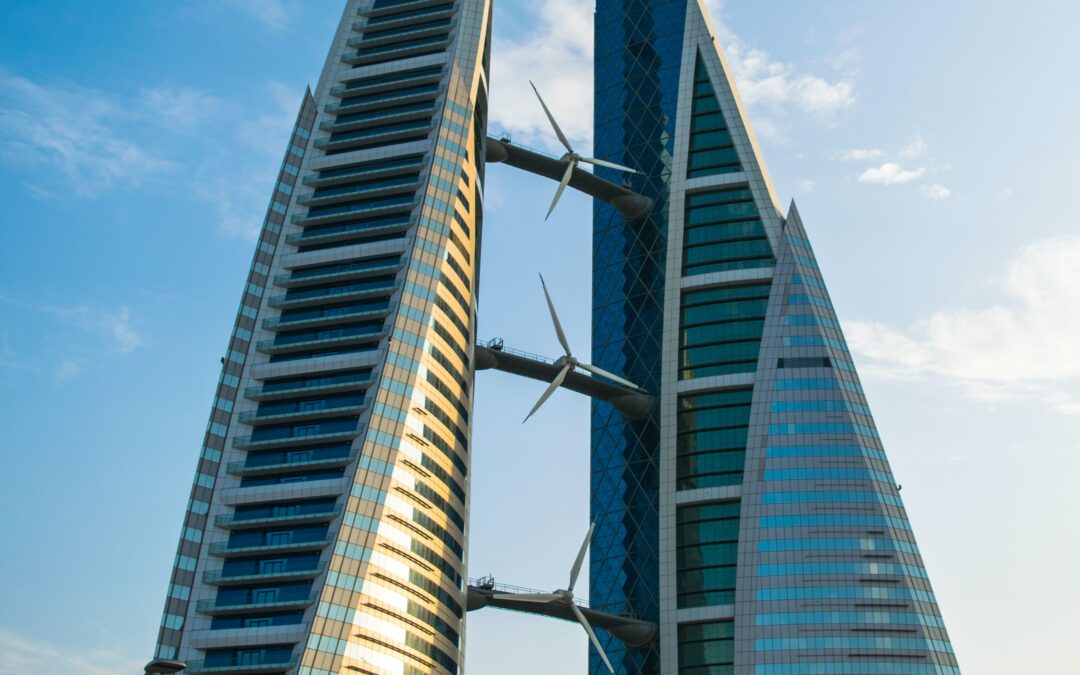The Four Seasons Hotel in Manama, at a height of 201 meters (885 feet), is the tallest building in Bahrain. The 50-floor skyscraper, completed in 2015 and designed by Skidmore, Owings & Merrill LLP, is the 61st tallest building in the Middle East and among the 400 tallest in the world. While Bahrain isn’t as known for its grandiose skyscrapers like some other Middle East countries, it does have several buildings over 200 meters (656 feet), and many have unique features and distinctions.
The Bahrain World Trade Center (WTC), for example, is a twin-tower complex connected by a trio of sky bridges, each holding a 225kw wind turbine. The two 50-story commercial office towers, constructed near the King Faisal Highway from 2004 to 2008, extend 240 meters (787 feet) into the sky and have received several awards for sustainability and design.
Here’s a closer look at what makes Bahrain WTC one of the most impressive structures in the country.
Third-Tallest Building in Bahrain
The Bahrain WTC was the third-tallest building in the country as of 2023 but will move to fourth in that category upon the completion of the 804-foot, 53-story Golden Gate Tower B. Dual Towers 1 and 2, at 853 feet tall, occupy the second position on Bahrain’s list of tallest buildings.
Built atop the five-star Sheraton Hotel complex overlooking the Arabian Gulf, the Bahrain WTC, designed by architectural firm Atkins, is a visually striking twin tower with a sail-like shape reminiscent of a dhow, a traditional Arabian trading vessel. The building cost $150 million to construct and its façade is made of a combination of steel and glass.
Wind Turbine Design and Sustainability
The Bahrain WTC was the first skyscraper to have wind turbines incorporated into its design to reduce its overall power consumption. By leveraging the building’s waterfront location and powerful sea breeze, the three 225kW wind turbines can generate as much as 15 percent of the required power consumption, which is the equivalent of about 300 homes. The turbines are 29 meters (95 feet) in diameter and were specially designed to allow wind velocity to funnel and accelerate. In addition, the two towers differ slightly at their peaks to mitigate differences in pressure between the three bridges and ensure equal velocity among the turbines.
The wind turbines, installed in 2007 and first turned in sync in April 2008, have a lifespan of 20 years. Small cranes can be mounted on each bridge to perform maintenance or replace turbine parts, while the generators are controlled via centers in the towers. The turbines were also cost-effective. Whereas prior wind turbine installation projects had been known to reach up to 30 percent of the total building cost, the three wind turbines for the Bahrain WTC amounted to just 3.5 percent of the overall project cost due in large part to “off-the-shelf” technology.
The wind turbines are far from the only environmental feature in the Bahrain WTC. High-quality solar glass with a low-shading coefficient, overhanging balconies, and enhanced thermal insulation on the building’s opaque fabric elements contribute to keeping the interior of the building cool. Other sustainable features include water recycling, low-leakage windows, and reflection pools to support evaporative cooling.
“We were told unofficially that a lot of the leaders in the Middle East started to see this as the future,” said Shaun Killa, design director for the Bahrain WTC. “There needs to be a new consciousness. This building’s success has contributed to a lot of the green initiatives in the region.”
The success of the Bahrain WTC and the effectiveness of the wind turbines prompted Atkins to incorporate a similar design into the Dubai International Finance Centre’s Lighthouse Tower. Today, there are several planned or completed wind projects in the Middle East, including the 28MW Hatta wind power project in Dubai and the 400MW Dumat Al Jandal utility-scale farm in Saudi Arabia, the largest wind project in the region.
List of Awards
From 2006 to 2010, the Bahrain WTC received 11 awards for its design and sustainable elements. It won the 2009 NOVA Award in Innovation for incorporating technology to not only enhance quality but reduce project cost. It also received the EDI Award for Environmental Excellence in 2007 and was recognized at the 2008 Building Exchange Awards, 2008 Construction Week Awards, and 2006 LEAD Awards. It also holds the distinction of being Bahrain’s first “intelligent building.” Atkins was named the Building Design Awards Architect of the Year for its design of the Bahrain WTC.
Tenants and Nearby Attractions
Tenants of the Bahrain WTC include Ernst & Young, Alliance Business Centers Network, and Elham Ali Hassan & Associates. The MODA Mall, at the base of the skyscrapers, is a beautifully designed shopping center with ornate marble floors and glass-domed roofs that maximize natural light. The mall boasts a range of specialty stores and world-class restaurants, as well as luxury fashion brands such as Louis Vuitton, Gucci, and Dolce & Gabbana. The five-star Sheraton Bahrain Hotel is right next to the Bahrain WTC.

